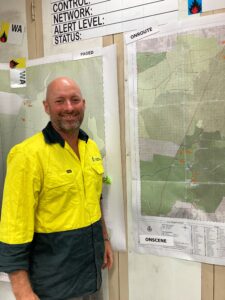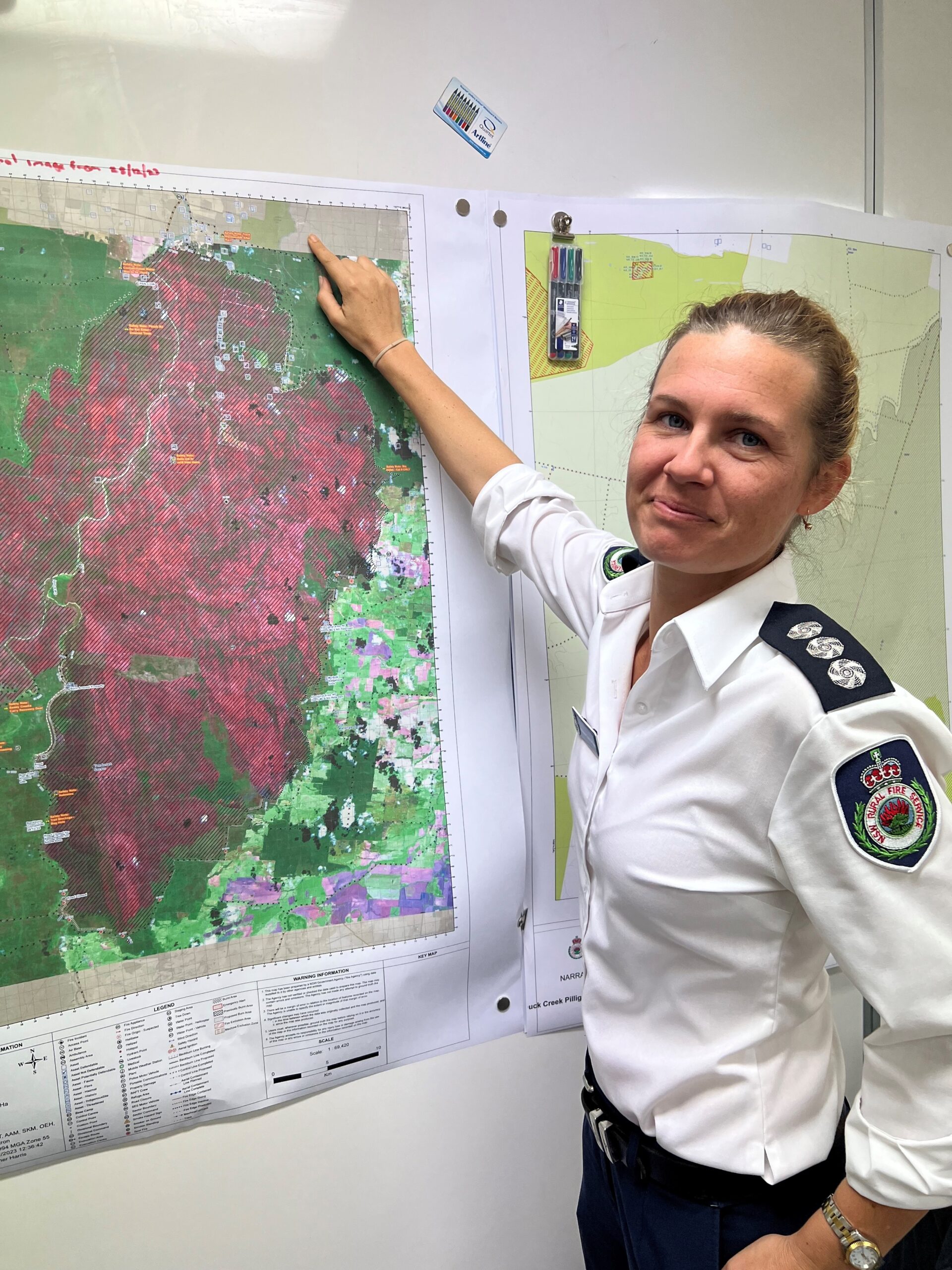Leaving your husband to defend your property while you manage a section 44 bushfire is just another day at the Rural Fire Service, and if that doesn’t say ‘stay cool and don’t lose your head’ then I don’t know what does.
‘Zen and the Art of Firefighting’ could be a book written by the multiple teams at the RFS Narrabri headquarters, and control room personnel put the ‘keep calm’ philosophy to good use, where staying in control is crucial to unpredictable fire efforts.
Narrabri native Katherine Scott-Dickson is a planning officer with 15 years in the service.
Her property was one of the first to be reached from the northeast Pilliga State Forest edge of Jacks Creek.
“For three days on nightshift I went to bed looking at a firestorm coming towards my home, then being woken up by evacuation orders,” said Katherine.
“The third day it happened, I couldn’t sleep because I thought I was going to be that person who was napping when the fire arrived, so my husband came home while I slept during the day.
“That’s when we had the storm come through in the afternoon and at this point, I don’t think they had any idea where the fire was because of the way storm cells work and it was too unsafe to put crews in.”
On that day, Katherine woke to an evacuation order, and her husband enacting their emergency evacuation plan, removing family paintings off the wall.
Katherine took her dogs with her to work and left her husband to defend the property because they still didn’t know what direction the fire was coming from.
“When I got to work, we got a triple zero call saying lightning had started a grassfire in my neighbour’s property … I was terrified,” said Katherine.
“My nephew rang to tell me my husband had gone out on a tractor to try and stop the spread because it was on a northern property and the fire was assumed to be west of us, which potentially put the fire on three sides.
“I’ll be honest, I was very stressed.”
While it was an impossible scenario to leave to her husband, Katherine knew that the control centre was the right place for her to be, executing her role as planning officer, and dealing directly with the response effort.
“I felt horrible to leave my husband, but we had a plan, and he was enacting it when we left.
“Knowing I was at headquarters with more knowledge of what was happening, I could only imagine how helplessly terrified members of the community would have been that didn’t understand what was going on.
“I have the ability to find out information and to help everyone, versus sitting at home and waiting with no idea.”
Katherine’s role as planning officer means dealing with the here and now – planning what will happen tomorrow, then taking that plan, implementing it, adapting it, “Or throwing it out the window,” she jokes.
“I coordinate all the humans on the fire ground, and we communicate with them what we need to achieve, it’s for those guys with the experience on the ground to work out what’s the best way to do it.
“We lead by objective. We don’t tell people how to do their job, we tell them what we want them to achieve.
In this case, that meant standing down, as readings from portable weather stations on the ground were all over the place.
“The fire activity we were having, meant it wasn’t safe for anybody to go near, so a lot of what we had to do was fall back and monitor where it was, but the fire was crowning at 3 am in the morning which was just ludicrous.”
Standing back and sitting on your hands is not something that comes easy to the RFS, but in an impossible scenario Katherine would do so for long stints, and risking the safety of her firefighters was never an option.
“Firefighters want to be hands-on, put wet stuff on the hot stuff, and be very direct with their approach–like conducting back-burning operations,” said Katherine.
“Yes, we don’t want to lose the Pilliga, it means a lot to us, I live on the edge of it but every single one of those humans’ lives means way more, it’s a very easy calculation.
“We don’t put them on the line if there’s any risk to them, we hold back, and we hope that people understand that sometimes that is the most proactive approach.”

Anton Groeneveld, deputy incident controller for NSW National Parks and Wildlife Service.
Forestry Corporation and National Parks and Wildlife were two state agencies who responded to the fire efforts and deputy incident controller for Parks – Narrabri-based Anton Groeneveld felt the season played out as expected.
“We came into the season dry with considerable fuel loads around the countryside – when we get lighting storms you would expect that there would be ignition somewhere,” said Anton Groeneveld.
Deputy incident controller for NSW Forestry Corporation, Gary Miller’s Day job is in Port Macquarie, but as the former Barradine Forest Centre manager from 2008-2011, he is well experienced in the countryside.
“When you look around the office in an emergency response, there are heaps of people and personalities responding to the situation,” said Gary.
Having been in control centres in Canada, Tasmania, NSW, and VIC, Gary considers NSW RFS control Centres to be the most combined that he’s seen for IMTs.
“This control room is particularly good – sometimes you get people with high energy or get a bit excited but this one is very well controlled and well-paced,” said Gary.
‘Everyone in their right place’ is a philosophy suited for a deputy incident controller, and the two agencies worked side by side with RFS to manage the emergency.
“I manage people, and sometimes you have to move people and personalities.”
“In a fire sense, you’ve got to communicate super effectively, and departments have to get on, particularly when things are hectic, it has to work and flow.
“A lot of IMT is making sure you’ve got the right people in the right job – quite often you won’t get to the point of being here if you’re going to panic.”
An IMT’s duties include looking at where people sit, what people are looking at – the maps on the board, what computer things they are looking at, and the systems that feed information in and out to the control centre.
“Each fire’s different depending on the incident controller and how they want to manage it, but the deputy is trying to make sure that the structure is working and that everyone’s in the right position.”
The control room uses an international emergency response structure used all over the world, with the deliberate setup, systems, and psychology also shared at a military level.
“Our job is to remain calm, graph it, and make sure we’re planning for 24/48 hours in front of the fire – that is the training and mindset of it,” said Gary.
So how do you stay calm in the face of a burning blaze?
“Overtime, people just get better at it.
“You can have a really good IMT and a bad outcome in the forest or vice versa but a lot of what we’re setting is strategic planning, which is making sure people are in the right spot, and safe, and that comes from here in the control centre,” said Gary.
“Little things like the radio chatter – if you start talking fast and yelling at people, you feel that in the field.
“So, you’ve got to set the pace, be calm, and set the motions, and that filters through.
While he prefers to be in the field, having fought fires for 20 years, Gary recognises the important role he now plays, and feels lucky to get to do both.
“It helps to have been out in the field as you don’t lose sight of what it’s like out there,” said Gary.
“It is very different to what we’re looking at in headquarters.
“On the ground – we’ll map a path as a small, straight line, but it will actually be steep and difficult terrain, that might take two hours to move around, and the Pilliga has a lot of hard country, contrary to what people think.”
Deputy incident controller for National Parks, Anton Groeneveld handles the resourcing of National Parks crews, checking the welfare of the crew, and making sure their part in the operation has been conducted promptly and safely while coordinating with RFS and other agencies.
“For this fire, it was half Forestry and half National Parks as far as tenure goes, so the southern part of fire has been burning through the state conversation areas down south and Pilliga nature reserve,” said Anton.
National Parks have 130 trained firefighters who can respond to wildfires with 50 crew on the ground at the height of this emergency, patrolling 60 km of fire reach, with Forestry doing the same.
“This was very much a wildfire and containment options were limited as it was running at such an intensity that we could only work on the flanks because it just wasn’t safe,” said Anton.
“I was here on a couple of days where it took big runs and we’re all going ‘my god …’ all you can do is wait for it to stop somewhere because no amount of water bombing is going to stop a fire with that type of intensity.
“I doubt this is the last fire we’ll have this year – crystal-ball gazing, I’m expecting new ignitions till the end of February unless we get a lot more rain.”
These human beings exhibit incredible patience and reservation in exceptional circumstances but acknowledge that even they have to implement personal strategies to master their own feelings of panic.
“Of course, you do get panicked when things ramp up, but you’ve got to go through the motions of ticking off the list in your mind,” said Gary.
“A technique we use is memory slides to remember each fire – so you’ll remember when you went through situations before and what you did that worked – and if you responded badly and panicked – then you think – well, I won’t do that.
And what’s it like standing in the face of a fire?
“Well, we try not to stand in front of the fire – most firefighting is not sexy or glamorous or exciting – and that’s the way we like it. We like it to be boring, controlled, and managed,” said Gary.
“Because even though it’s an emergency, it shouldn’t be unorganised chaos.
“Chaos is the exact opposite of what we want. We want control, not chaos.”

Gary Miller was the Forestry Corporation NSW deputy incident controller for the s44 emergency.










